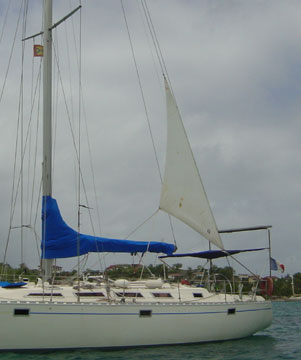Dynamic Behavior (3) - Yawing and Swinging
1. Introduction
Up to now, we have assumed the boat is perfectly symmetrical and the direction of the wind does not change, so that everything remains in a fixed vertical plane, parallel to the wind. Obviously, this is not the case in real situations! Even in settled weather, the wind direction fluctuates around a mean value, especially when the anchorage is surrounded with hills, cliffs etc. that vary the air flow. This destroys the symmetry of the scene, which results in 2D motions.
Since the boat is tied from its bow to a fixed point by a long rode, one could believe the boat would tend to follow the wind variations, with some delay due to the inertia. Unfortunately, this belief is wrong! Physically, an anchored boat is an unstable system, mainly because of its topsides that act as a (bad) foresail. Actually, the wind tends to put the boat broadside to the wind, whereas the rode tension tends to bring it back into the wind. In addition, as soon as the boat moves relatively to the water, the hull and the keel go into action (lift and drag forces). Since most of the involved parameters vary, the system never reaches an equilibrium, and the motions are very complex.
 |
| Figure 2.3.1 - Yawing under Mistral gusts (NE Sardinia) |
Thanks to reasonable simplifications, however, a simulation is possible that reproduces the behavior of actual anchored boats. It needs 3 major components:
Such a model is used in the following animation and in the spreadsheet presented below.
2. An Example
The following animation shows a typical (but somewhat accelerated) yawing/swinging behavior:
Note: Playing the animation needs the proper Adobe Shockwave PlayerŽ to be installed in your computer. If not already installed, you can download it here.
Click
on this image 
3. Yawing and Swinging Consequences
Yawing dramatically increases the windage forces (see the Rode Forces chapter), and surging efforts increase proportionally. As we noticed in the previous pages, even when using long scopes, high tensions can lift the whole rode and the anchor shank, which considerably decreases the holding power.
Swinging constantly modifies the direction of the force that pulls the anchor shank ("wiper" effect), which decreases the holding power even further. When combined with the violent jolts caused by jerking and yawing, this can lead to dragging - not to mention breaking parts of equipment - even in wind conditions that otherwise would be easy to handle.
In addition, in crowded anchorages, since the various boats swing differently, the risk of bumping or crashing dangerously increases (fig. 2.3.2).
 |
| Figure 2.3.2 - Glad to have anchored my boat windward of this... object! Notice how untidily the other boats yaw under the gust (Palmeira - Ilha do Sal - Cape Verde) |
Note: Please remember that when the wind exceeds, say, 30 kt, you cannot rely on the friction of the chain that may still lie on the seabed to significantly reduce those disastrous effects: all the efforts that act on the boat reflect in the anchor almost entirely!
4. How to Reduce Yawing and Swinging?
4.1. Factors
Whatever their sizes and types, all boats are prone to yawing and swinging, but some are more affected than others. Knowing the main factors that have an appreciable effect on yawing and swinging can be useful in 2 situations:
In addition to the value of the various active forces, yawing and swinging depend mainly on the relative longitudinal positions of 4 geometric points in the boat:
 |
| Figure 2.3.3 - Yawing and Swinging Forces |
In a well balanced sailboat (underway), G, A and H are closed to each other. For an anchored boat (whether it be a powerboat or a sailboat with its sails down), A usually is forward of G. If this is the case, the aerodynamic force in A generates a torque that tends to swivel the boat off the wind. When the yaw angle increases, however, the aft parts of the topsides, rigging and deck structures become predominant, so A moves aft and finally goes past G, which reverses the motion.
This does not occur, however, if A is far enough from the roller B to result in an opposite torque.
Underwater appendices lift forces can either increase or reduce those effects, depending on their size and the position of H:
 |
| Figure 2.3.4 - Before a squall in Isla La Blanquilla (Venezuela) |
4.2. Solutions
From the discussion above, for an existing boat, a few solutions emerge:
 |
 |
|
| Figure 2.3.5a - Drunk skipper's storm jib | Figure 2.3.5b - Are 2 better than 1? |
5. Run Your Own Simulations
You can download, uncompress then run the spreadsheet yawswing.xls that was used for the above example (requires Microsoft® Excel 2011 or +).